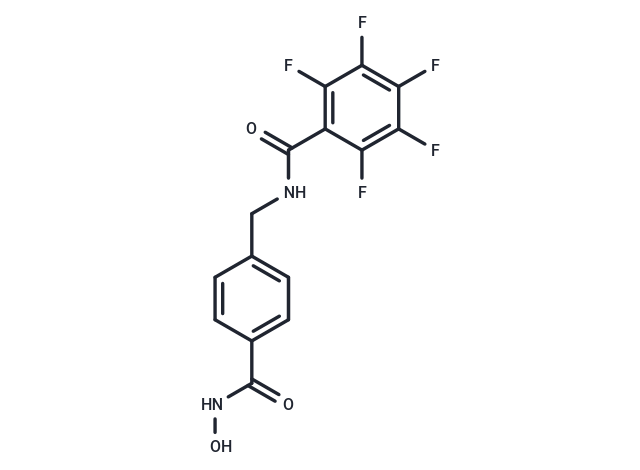Shopping Cart
Remove All Your shopping cart is currently empty
Your shopping cart is currently empty
PTG-0861 is a highly specific inhibitor of histone deacetylase 6 (HDAC6), demonstrating an impressive IC50 value of 5.92 nm. This compound effectively triggers apoptosis and holds potential for research pertaining to acute myeloid leukemia, multiple myeloma, and other hematological cancers [1].

| Pack Size | Price | USA Warehouse | Global Warehouse | Quantity |
|---|---|---|---|---|
| 25 mg | $1,520 | 6-8 weeks | 6-8 weeks | |
| 50 mg | $1,980 | 6-8 weeks | 6-8 weeks | |
| 100 mg | $2,500 | 6-8 weeks | 6-8 weeks |
| Description | PTG-0861 is a highly specific inhibitor of histone deacetylase 6 (HDAC6), demonstrating an impressive IC50 value of 5.92 nm. This compound effectively triggers apoptosis and holds potential for research pertaining to acute myeloid leukemia, multiple myeloma, and other hematological cancers [1]. |
| Targets&IC50 | HDAC6:5.92 nM |
| In vitro | PTG-0861 (compound 54) at concentrations ranging from 0.1 to 5 μM over 6 hours enhances acetylated a-tubulin expression and exhibits inhibitory effects on HDAC6, with an IC 50 value of 0.59 μM. Furthermore, at concentrations of 0 to 4 μM for 18 hours, PTG-0861 induces apoptosis in a dose-dependent manner and demonstrates cytotoxicity. Western Blot analysis on MV4-11 cells, with a concentration range of 0.1-5 μM over 6 hours, revealed an increase in acetylated a-tubulin expression, particularly noted at 500 nM. Additionally, immunofluorescence in HeLa cells at 0-2 μM for 6 hours showed elevated levels of acetylated a-tubulin starting from 0.1 μM. Apoptosis analysis in MV4-11 cells indicated around 18% late apoptosis at 4 μM and approximately 5% at a lower dose of 0.25 μM over 18 hours. Cell cytotoxicity assay in hematological cancer cell lines (MV4-11, MM.1S, RPMI 8226) over 72 hours at concentrations of 1.24-4.94 μM revealed cytotoxic effects with IC 50 values of 1.85 μM, 1.9 μM, and 4.94 μM, respectively. Moreover, PTG-0861 pharmacokinetic parameters in vitro demonstrate a notable stability and permeability, indicating efficient cellular uptake and metabolism characteristics. |
| In vivo | Oral administration of PTG-0861 (compound 54) at a dosage of 20 mg/kg daily for five days demonstrated no impact on body weight and no evident toxicity in CD1 mice [1]. Furthermore, a single intraperitoneal injection of the same dose in male CD1 mice revealed pharmacokinetic properties of PTG-0861, including a half-life of 0.25 hours, a peak concentration (C max) of 526 ng/mL, and area under the curve (AUC) values of 190 h ng/mL for AUC last and 219 h ng/mL for AUC inf, indicating minimal extrapolation from the last to infinite time (AUC Extr(%)) of 0.324%, with a mean residence time (MRT) of 0.350 hours and dose-normalized AUC (AUC/D) of 9.5 h mg/mL. |
| Molecular Weight | 360.24 |
| Formula | C15H9F5N2O3 |
| Cas No. | 2494082-34-5 |
| Smiles | C(NCC1=CC=C(C(NO)=O)C=C1)(=O)C2=C(F)C(F)=C(F)C(F)=C2F |
| Storage | Powder: -20°C for 3 years | In solvent: -80°C for 1 year | Shipping with blue ice/Shipping at ambient temperature. |
| Size | Quantity | Unit Price | Amount | Operation |
|---|

Copyright © 2015-2026 TargetMol Chemicals Inc. All Rights Reserved.